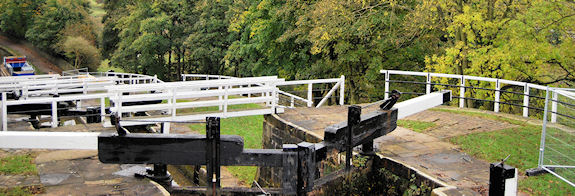
The most impressive rise in England with a fall of 18 m (60 ft).
Beck Lane, Bingley, BD16 4DS
The Leeds & Liverpool Canal was the first of the Trans-Pennine canals to be started - and the last to be completed. The length and complexity of the route meant that the canal took an astonishing 46 years to build at a final cost that was five times the original budget.
The canal originates from a proposal in 1765 to construct a canal from Preston to Scarborough and Hull, with Leeds and other twosn served by branches. Limestone from Skipton and fish from Scarborough were suggested as important cargoes. It was soon realised that the canal would be too expensive for the Bradford merchants behind the scheme, and the route was shortened to Leeds to Liverpool. The line of the canal, over 108 miles long, was laid out along the Aire valley by James Longbotham, a local surveyor. James Brindley, was asked to approve the route, though he left this to his assistant Robert Whitworth, who eventually became the canal's engineer in the 1790's until his death in 1801. Brindley was offered the post of engineer but he declined because he had so much other work. Longbotham was left in charge of the initial works. With Liverpool now proposed as the western terminus, local merchants and shipowners showed great interest, arguing that the canal should also serve the Wigan coalfield. The two groups fell out over this, with the ‘Bradford’ route being used to obtain the Act in 1770. However, it was agreed to build from both ends, and Wigan would be served by a connection from the Douglas Navigation.
River navigation couldn't solve all the transport problems of industrial Yorkshire, so artificial waterways, or canals, were cut into the landscape. With the Pennines being so hilly, locks had to be introduced to raise or lower the level of the canal. Bingley Five Rise lock, which alters the height of the water by almost 60 ft, is the most impressive in Britain, though it was not innovative. A seven-rise flight had been built on the Canal de Briare in 1642. However the Bingley is an amazing engineering feat, showing man's dominamnce over the environment, a key factor in the industrial revolution. This stretch of the canal was opened on 21st March 1774, and the first boat down the Five Rise Locks took 28 minutes. The locks were set out by John Longbotham of Halifax and built in 1774 by local Stonemasons. An 18th century engineering masterpiece, these five locks operate as a 'staircase' flight in which the lower gate of one lock forms the upper gate of the next. When completed, thousands gathered to watch the first boats make the 18 m (60 ft) descent.
The staircase locks are slow to operate since all five must be 'set' before beginning passage. For a journey upwards, the bottom lock must be empty, with all the others full: the reverse is the case for a boat descending. It can take up to ninety minutes for a boat to work through the flight. The five-rise is the steepest flight of locks in the UK, with a gradient of about 1:5. The intermediate and bottom gates are the tallest in the country. Because of the complications of working a staircase lock, a full-time lock keeper is employed. Only a few hundred yards downstream is another staircase - this time a three-rise flight, with a fall of 9 m (30 ft).
The staircase underwent extensive restorative maintenance in 2004, and again in 2006 when the lock gates and paddles were replaced. A great deal of ongoing maintenance is required and the staircase is frequently part British Waterway's winter stoppage schedule.
Text from Mike Clarke, with thanks.
By road: Off A650 via Canal Road
By rail: Via Crossflatts Station

Atterbury, Paul. English Rivers and Canals. ISBN. 0 297 78318 1 (1984)
Bartholomew. Nicholson Inland Waterways Map of Great Britain. ISBN 978-00072 11173. (2006)
Biddle, Gordon, Pennine Waterway: Pictorial History of the Leeds and Liverpool Canal, Dalesman Publishing, ISBN-10: 0852064276 (1978)
Boughey, Joseph. Hadfield's British Canals: the Inland Waterways of Britain and Ireland.
ISBN 978 18401 50247. (1998)
Boughey, J. and Hadfield, C. British Canals: A Standard History . ISBN 978-07524 46677. (2008)
Burton, A. The Waterways of Britain. ISBN 0 00 218047 2 (1983)
Clarke, M. Leeds & Liverpool Canal:A Pictorial History and Guide, Carnegie Publishing, ISBN-10: 1859360130 (1998)
Firth, Gary, The Leeds and Liverpool Canal in Yorkshire, NPI Media Group, ISBN-10: 0752416316 (1999)
Fletcher, J. & M. The History and Operation of Barton Swing Aqueduct (1992)
Gladwin, D.D. A Pictorial History of Canals. ISBN 0 7134 0554 6 (1977)
Hadfield, C., Canals of Yorkshire and North East England, David & Charles, ISBN-10: 0715359754 (1973)
Pratt, D. Waterways Past and Present: A Unique Record of Britain's Waterways Heritage. ISBN 978-07136 76341. (2006)
Pratt, F. Canal Architecture in Britain. ISBN 978- 09032 18139. (1976)
Roberts, B. Britain's Waterways: A Unique Insight. ISBN 978- 08635 11158. (2006)
Rolt, L.T.C. Inland Waterways of England. (1950)
Ware, M.E. Britain's Lost Commercial Waterways. ISBN 978-18430 61816. (2005)